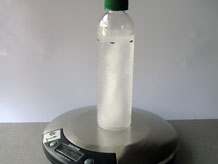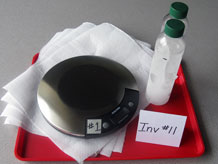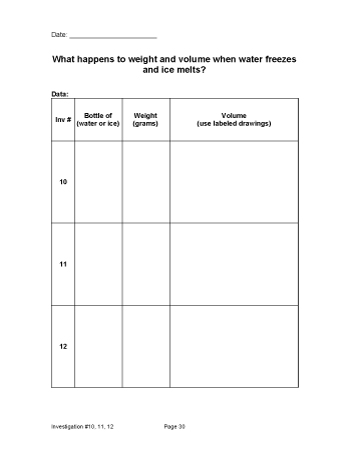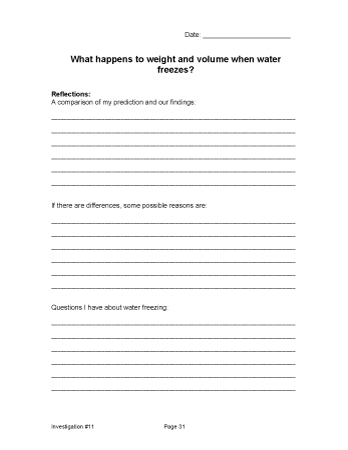What happens to weight and volume when water freezes?
Plan Investigation 11

How much can something change and still remain the same? When water freezes, the changes seem dramatic, and yet the kind of matter remains the same - it's still water. While liquid water and frozen water have different names and some different properties, the kind of matter remains the same, and for a specific sample of water, the weight does not change. The volume of a sample is not conserved across a phase change. Freeze water and its volume will increase. Evaporate that same sample of water and its volume will increase even more, but its weight will be conserved.
Formative Assessment
What happens to weight when water freezes?
Available online at inquiryproject.terc.edu
What happens to weight when water freezes?
You can find evidence of students’ ability to interpret class data by listening to their make meaning discussion.
Listen for these ideas about discrepant weight data as you interpret students’ explanations:
- A small weight increase occurred because we didn’t wipe off the condensation that was added to the outside of the container.
- A weight loss is due to water seeping out of a cracked container.
- A small change in weight (+/- 1-2 grams) could be due to the inaccuracy of the scale.
A next step might be to have students return to their predictions and ask if anyone is thinking differently now about what happens to the weight and volume of water when it freezes.
In this session, students follow up on an investigation they launched in the previous class. They discover that the volume of their samples increased as the water froze, but they may have mixed results when they report on the weight. The question of weight can be complicated by inaccurate scales, condensation that forms on the outside of the bottles, and a tendency to believe that if the volume of a sample increases, so must the weight. While the topic of condensation is not related to the investigation question, its appearance on the frozen containers affords an opportunity to discuss this process, which is so common and yet still mysterious to many.
By the end of this session students will have evidence that the volume of their water samples increased and weight stayed the same across the phase change from liquid to solid.
Learning Goals
- Understand that across phase change, while the volume changes, the weight of a sample stays the same
- Understand that weight is the reliable measure of the amount of matter
| Sequence of experiences | ||
|---|---|---|
| 1. Ask the question | All Class | 5 Mins |
| 2. Collect data | Small Groups | 10 Mins |
| 3. Share findings | All Class | 15 Mins |
| 4. Make meaning | Discussion | 15 Mins |
Materials and Preparation
For the class:
- Post the investigation question in a place where all students can see it.
- Make a class chart titled, "Transforming Water to Ice and Ice to Water"; an example is found in Step 3.

- Recover the bottles from the freezer as close as possible to start of class. Insulate the bottles as necessary to keep them frozen until students get them.
For each group:
- 1 digital scale
- 2 plastic bottles prepared in the last class that are now frozen
- 4 paper towels








